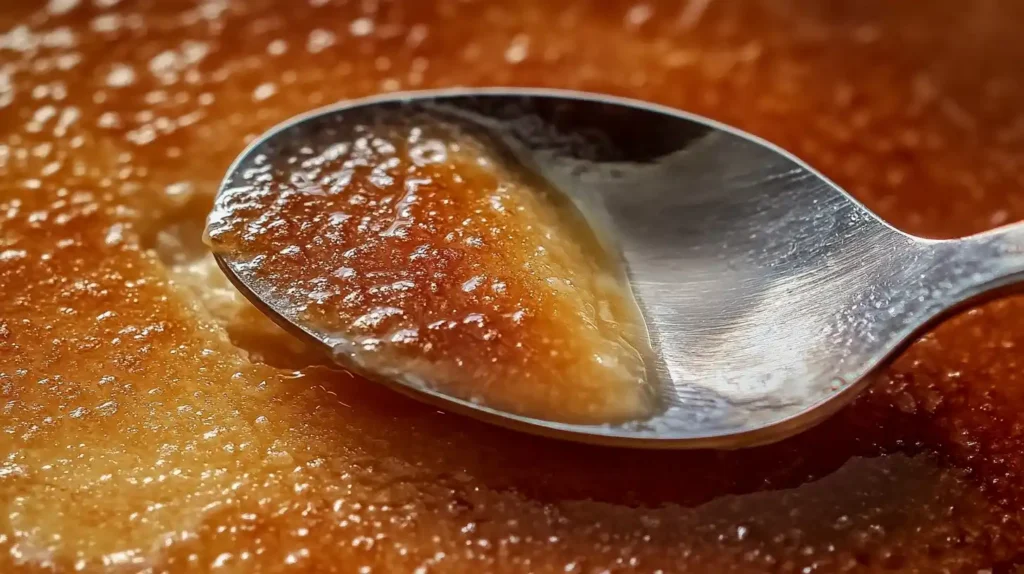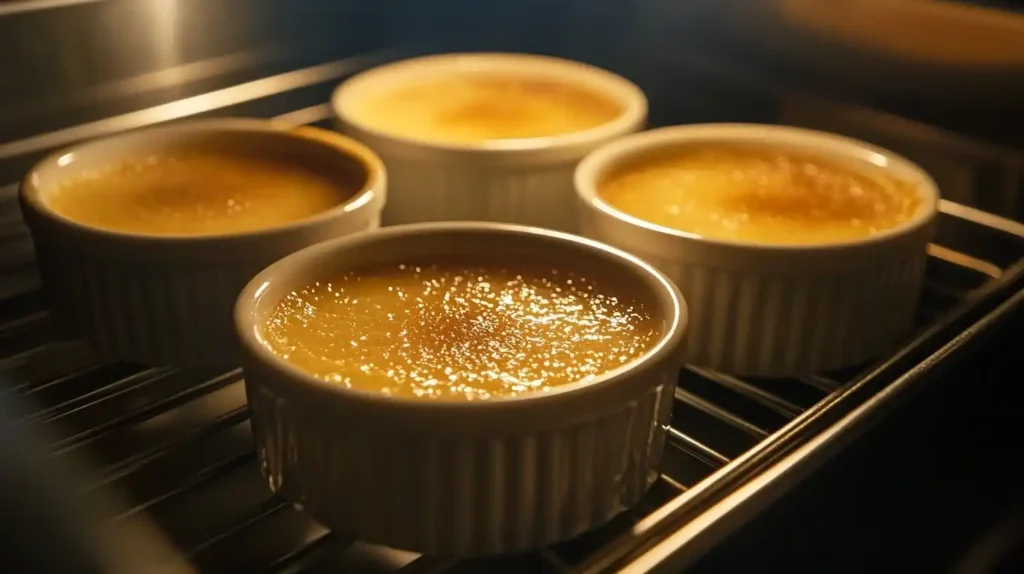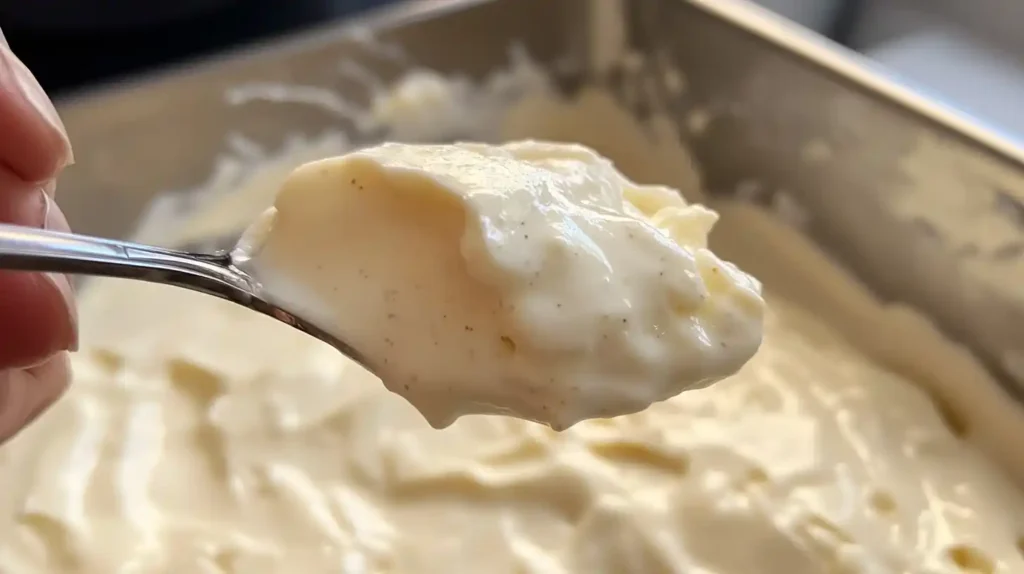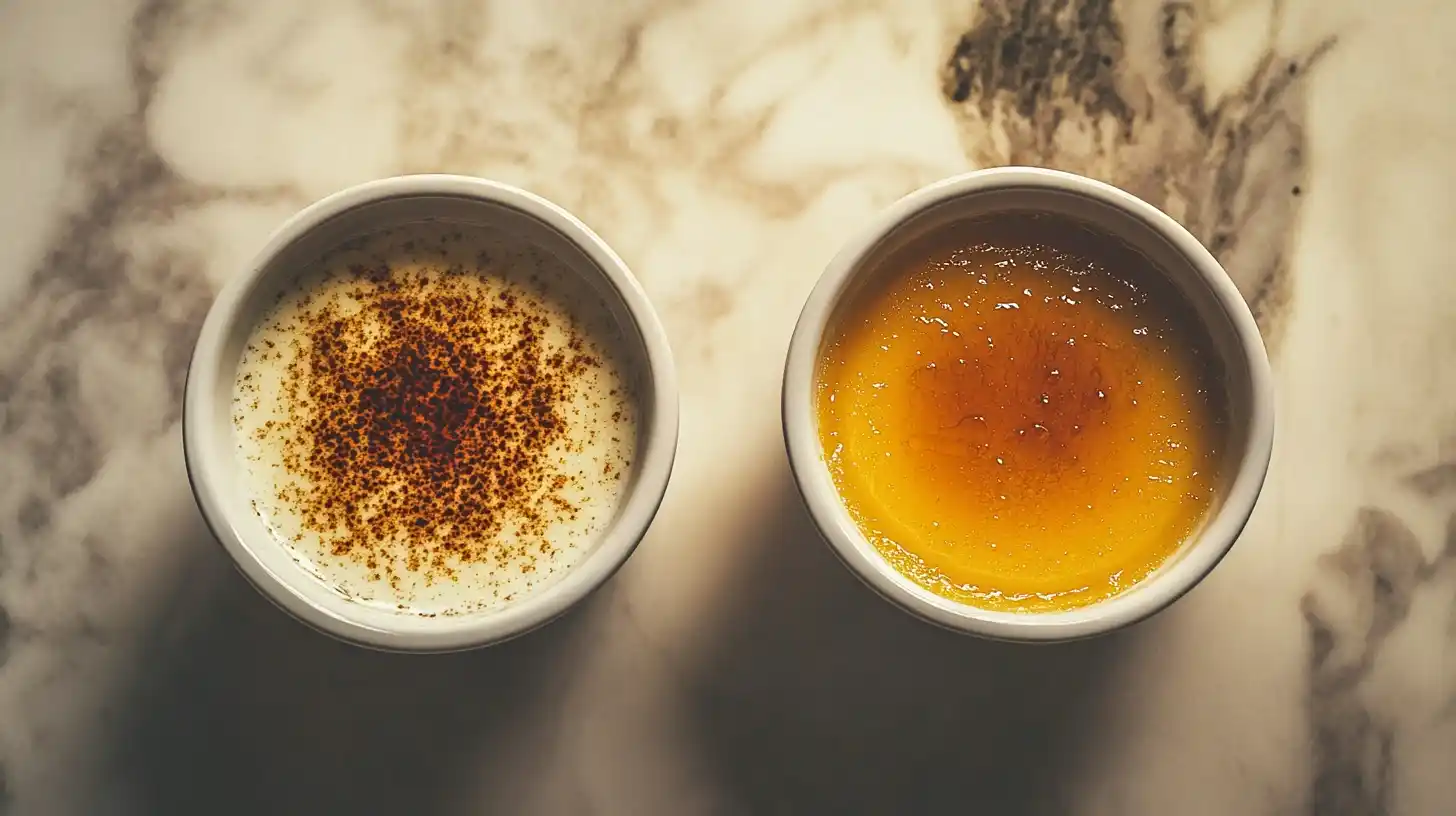If you’ve ever wondered about the difference between crème brûlée and custard, you’re not alone. These two classic desserts both have a rich, creamy texture and share similar ingredients, including dairy, eggs, and sugar. However, despite these similarities, they differ in texture, preparation, and overall flavor.
In this article, you’ll explore what makes crème brûlée and custard unique, how they are made, and which one might be the perfect dessert for you. Additionally, you’ll learn some expert tips on how to master each recipe at home.
Table of contents
What is Crème Brûlée?
Origins and Meaning
The name crème brûlée translates to “burnt cream” in French, referring to its signature caramelized sugar topping. This elegant dessert has been a staple in fine dining for centuries. Although its exact origin remains uncertain, many culinary historians believe it dates back to the 17th century.

While France is often credited with its invention, variations of this dessert have appeared in other European cuisines.
- France: The classic crème brûlée we know today is commonly associated with French cuisine. Over time, it has become a symbol of indulgence and sophistication.
- England: A similar dessert called Trinity Cream was first recorded at Trinity College, Cambridge, in the late 1600s. This English version closely resembles crème brûlée, but chefs often used a hot iron to caramelize the sugar topping.
- Spain: In Catalonia, Spain, a dessert known as Crema Catalana shares many similarities with crème brûlée. However, unlike the French version, it is traditionally made with milk instead of cream and flavored with cinnamon and citrus zest.
Regardless of its true origin, one thing remains clear crème brûlée is among the most beloved French desserts worldwide.
A Perfect Contrast of Textures
What sets crème brûlée apart from other custards is its unique combination of textures. The crisp, caramelized sugar crust on top provides a satisfying crunch, which contrasts beautifully with the smooth, velvety custard beneath. This balance of textures and flavors makes every bite a luxurious experience.
Unlike other custards that are simply baked or stirred, crème brûlée requires an extra step—the sugar topping must be torched or broiled to create a golden, glass-like finish. This caramelized layer not only enhances the dessert’s appearance but also introduces a subtle bitterness that balances the creamy sweetness.
How Crème Brûlée is Made
Making crème brûlée requires a few essential steps:
- Gather the Ingredients: Heavy cream, egg yolks, sugar, and vanilla extract.
- Mix and Heat:
- First, whisk the egg yolks and sugar together.
- Then, heat the cream and slowly pour it into the egg mixture to prevent curdling.
- After combining, pour the mixture into shallow ramekins.
- Bake with a Water Bath:
- Place the ramekins in a deep pan.
- Pour hot water into the pan, surrounding the ramekins halfway.
- Bake until the custard is firm but slightly jiggly.
- Caramelize the Sugar:
- Once chilled, sprinkle a thin sugar layer on top.
- Use a torch or broiler to caramelize it, creating a golden, glass-like crust.

What Makes Crème Brûlée Unique?
- Caramelized Sugar Topping: The thin, hardened sugar layer adds a satisfying crunch.
- Rich, Creamy Texture: Due to its high cream content, crème brûlée has a silkier texture.
- Shallow Ramekin Serving: This allows for more caramelized surface area.
- Endless Variations: While vanilla remains the classic flavor, options like coffee, matcha, citrus, and chocolate are also popular.
What is Custard?
Definition and History
Custard is a creamy, egg-based dessert that serves as the foundation for countless sweets. Unlike crème brûlée, which is a specific type of baked custard, custard itself is a broad category that includes baked, stirred, and steamed variations. Due to its versatility, it appears in numerous cuisines across the world.
The origins of custard date back to medieval Europe, where cooks used it primarily as a pie filling. Over time, different cultures developed their own unique versions. Today, it is a staple in both sweet and savory dishes, making it one of the most adaptable desserts in culinary history.
- France: The French refined custard into crème anglaise, a smooth and pourable sauce often paired with cakes and pastries. They also created flan and crème caramel, which are baked custard desserts served with a soft caramel topping.
- England: British cuisine features egg custard tarts, a simple yet delightful dessert with a flaky crust and silky filling.
- Spain and Portugal: Spanish flan and Portuguese pastéis de nata showcase custard’s rich, creamy texture with a caramelized or flaky pastry exterior.
- Asia: Many Asian cuisines incorporate steamed custard, often flavored with coconut milk, pandan, or even savory ingredients like soy sauce and chicken broth.
Since custard is so flexible, it can be used in numerous recipes. For a delicious and creative twist, consider incorporating it into other baked goods, such as brownies. You can try Cottage Cheese Brownies for a high-protein alternative with a custard-like texture.
A Classic Base for Many Desserts
Custard is not just a dessert on its own it plays a vital role in many beloved sweets. Due to its smooth consistency and mild flavor, it pairs well with cakes, pastries, and even frozen treats. Some of the most well-known custard-based desserts include:
- Pastry Cream (Crème Pâtissière): A thickened custard used as a filling for éclairs, cream puffs, and fruit tarts.
- Crème Anglaise: A thin, pourable custard sauce drizzled over cakes, puddings, or fresh fruit.
- Flan and Crème Caramel: These baked custards have a caramel layer on top that adds both sweetness and complexity.
- Frozen Custard: A richer version of ice cream made with egg yolks, resulting in a smoother, creamier texture.
Custard is also an excellent ingredient for savory recipes, such as quiches, soufflés, and even creamy pasta sauces. Its ability to adapt to both sweet and savory dishes makes it a must-have in any kitchen.
How Custard is Made
The process of making custard varies depending on the desired consistency and preparation method. However, the core ingredients remain the same:
- Milk or Cream: The base liquid that provides a rich and smooth texture.
- Eggs: The primary thickening agent, which gives custard its characteristic structure.
- Sugar: Sweetens the mixture and enhances the overall flavor.
- Flavorings: Vanilla, cinnamon, nutmeg, citrus zest, or even liqueurs can add depth and complexity.
Three Common Ways to Prepare Custard
- Baked Custard:
- The mixture is poured into ramekins or a baking dish.
- It is then placed in a water bath and baked at a low temperature.
- The result is a firm yet creamy texture, commonly seen in flan, crème caramel, and egg tarts.
- Stirred Custard:
- This version requires continuous stirring over low heat to prevent curdling.
- It remains silky and pourable, making it ideal for crème anglaise, pastry cream, and custard sauces.
- Steamed Custard:
- Popular in Asian cuisine, this method involves steaming the custard mixture until it sets.
- It is often served in both sweet and savory dishes, such as dim sum-style egg custard or Chinese steamed eggs.
Each method produces a different texture and consistency, allowing custard to be enjoyed in a wide variety of ways.
Why Custard is So Versatile
Custard’s smooth and creamy texture makes it a fantastic base for numerous desserts. Unlike crème brûlée, which always has a hardened caramelized sugar topping, custard remains soft and adaptable.
Additionally, custard can be:
- Eaten on its own as a standalone dessert.
- Used as a filling for pastries, pies, and layered cakes.
- Blended into frozen treats like ice cream or frozen custard.
- Incorporated into savory dishes, such as quiches, soufflés, and sauces.
Key Differences Between Crème Brûlée and Custard
Now that we’ve covered both desserts, let’s examine their main differences.
1. Texture and Consistency
- Crème Brûlée: Silky custard topped with a hard caramelized sugar crust.
- Custard: The texture varies—some are thick and creamy, while others are firm and sliceable.

2. Cooking Method
- Crème Brûlée: Always baked and finished with a caramelized sugar topping.
- Custard: Can be baked, stirred, or steamed, making it more versatile.
3. Flavor Profile
- Crème Brûlée: The caramelized sugar introduces a slightly bitter contrast to its sweetness.
- Custard: Typically mild and neutral, which allows for various adaptations.
4. Presentation
- Crème Brûlée: Served in individual ramekins with a shiny, crisp sugar top.
- Custard: Often used as a filling or served in a dish.
5. Culinary Uses
- Crème Brûlée: A standalone dessert, ideal for special occasions.
- Custard: Found in pies, pastries, trifles, and ice creams.
FAQs: Common Questions About Crème Brûlée and Custard
When it comes to crème brûlée and custard, people often ask about their differences, preparation methods, and variations. To help you master these beloved desserts, we’ve compiled a list of the most frequently asked questions along with detailed answers.
1. Is Crème Brûlée a Type of Custard?
Yes, crème brûlée is a type of baked custard, but not all custards qualify as crème brûlée. Both share similar base ingredients milk or cream, eggs, and sugar. However, crème brûlée is unique because it has a crisp caramelized sugar topping, which is achieved by torching or broiling the sugar layer after baking.
In contrast, custard is a broader category that includes:
- Baked custards like flan and crème caramel, which feature a soft caramel sauce.
- Stirred custards like crème anglaise, which remains liquid and is often used as a dessert sauce.
- Steamed custards, which are common in Asian cuisine and can be sweet or savory.
Since crème brûlée falls under the baked custard category, it is technically a custard with an additional caramelization step.
2. Can You Make Crème Brûlée Without a Torch?
Yes! While a kitchen torch is the most common tool for caramelizing the sugar, you can achieve similar results using an oven broiler. Here’s how:
- Set your oven’s broiler to high.
- Sprinkle a thin, even layer of granulated sugar over the chilled custard.
- Place the ramekins on the top rack of the oven.
- Watch closely and remove them once the sugar caramelizes (about 1-3 minutes).
For the best results, use superfine sugar because it melts quickly and evenly, forming a perfectly crisp crust.
3. What Are the Key Differences Between Crème Brûlée and Custard?
Although crème brûlée and custard share a common foundation, they differ in texture, preparation, and presentation.
| Feature | Crème Brûlée | Custard |
|---|---|---|
| Caramelized Topping | Yes, hard sugar crust | No, unless it’s crème caramel |
| Cooking Method | Baked, then torched | Baked, stirred, or steamed |
| Texture | Silky custard with a crunchy top | Can be soft, firm, or pourable |
| Common Uses | Served as a standalone dessert | Used in pies, pastries, and sauces |
While crème brûlée is typically served on its own, custard is often incorporated into other desserts, such as pies, trifles, and pastries.
4. Can You Make a Vegan Version of Crème Brûlée or Custard?
Yes! You can create dairy-free and egg-free versions of both desserts using plant-based substitutes.
Vegan Crème Brûlée
- Replace heavy cream with coconut cream, almond milk, or oat milk.
- Use cornstarch, agar-agar, or silken tofu instead of eggs to thicken the custard.
- Caramelize sugar as usual to achieve the signature crispy top.
Vegan Custard
- Swap milk for soy milk, coconut milk, or cashew milk.
- Thicken with arrowroot powder, cornstarch, or blended cashews.
- Sweeten with maple syrup or agave for a natural taste.
Although the texture will differ slightly, both vegan versions provide creamy, delicious alternatives to traditional recipes.
5. What Are Some Popular Custard-Based Desserts?
Custard is a key ingredient in many classic desserts, including:
- Flan (Crème Caramel): A baked custard with a soft caramel layer.
- Pastry Cream (Crème Pâtissière): A thick custard used in éclairs, cream puffs, and fruit tarts.
- Frozen Custard: A richer, creamier version of ice cream.
- Egg Tarts: A flaky pastry filled with sweet custard.
- Bread Pudding: A baked dessert that combines custard with soaked bread pieces.
Each of these delicious custard-based desserts highlights the ingredient’s versatility in different cuisines.
6. What is the Best Sugar for the Crème Brûlée Topping?
For the perfect caramelized crust, use superfine sugar (also called caster sugar). It melts quickly and evenly, creating a thin, crisp shell that shatters when tapped with a spoon.
If you don’t have superfine sugar, you can:
- Pulse granulated sugar in a food processor for a few seconds.
- Use raw sugar (turbinado sugar) for a deeper caramel flavor (though it may take longer to melt).
Avoid powdered sugar, as it doesn’t caramelize properly and can burn unevenly.
7. How Do You Prevent Custard from Curdling?
Custard can curdle if it is cooked too quickly or at too high a temperature. To ensure a smooth texture, follow these important tips:
- Use low heat and cook gradually.
- Temper the eggs by adding warm liquid slowly instead of pouring it all at once.
- Use a water bath (bain-marie) when baking custard-based desserts like crème brûlée or flan.
- Stir constantly when making stirred custards to prevent lumps.
When properly prepared, custard should have a silky-smooth consistency with no graininess.
8. What Are Some Creative Flavor Variations for Crème Brûlée and Custard?
While vanilla is the traditional flavor, there are many exciting ways to add variety:
- Chocolate: Melted chocolate or cocoa powder creates a rich, decadent version.
- Espresso: Strong brewed coffee enhances the custard with a bold, deep flavor.
- Matcha: Green tea powder adds a unique earthy note.
- Lavender or Rose: Infuse the cream with floral flavors for an elegant twist.
- Citrus Zest: Lemon, orange, or lime zest provides a refreshing balance.
For an extra layer of indulgence, some chefs even add liqueurs like Grand Marnier, Amaretto, or Bailey’s to the custard base.
9. How Long Does Crème Brûlée Last in the Fridge?
Properly stored, crème brûlée can last 3-4 days in the refrigerator. However, it’s best to caramelize the sugar topping just before serving to maintain its crisp texture.
To store crème brûlée correctly:
- Cover each ramekin with plastic wrap to prevent odors from seeping in.
- Do not freeze baked custard, as it may separate when thawed.
If you need to prepare it in advance, make the custard a day or two ahead and caramelize the sugar topping right before serving.
Final Thoughts
When choosing between crème brûlée and custard, consider:
- Texture Preferences: If you enjoy a crunchy sugar top, go for crème brûlée.
- Versatility: If you need a dessert for pies or pastries, custard is the better option.
- Difficulty Level: Custard is simpler, while crème brûlée takes a bit more skill.
Both desserts are delicious and timeless. Whether you’re indulging in a luxurious spoonful of crème brûlée or enjoying a creamy, classic custard, you’re in for a treat!

